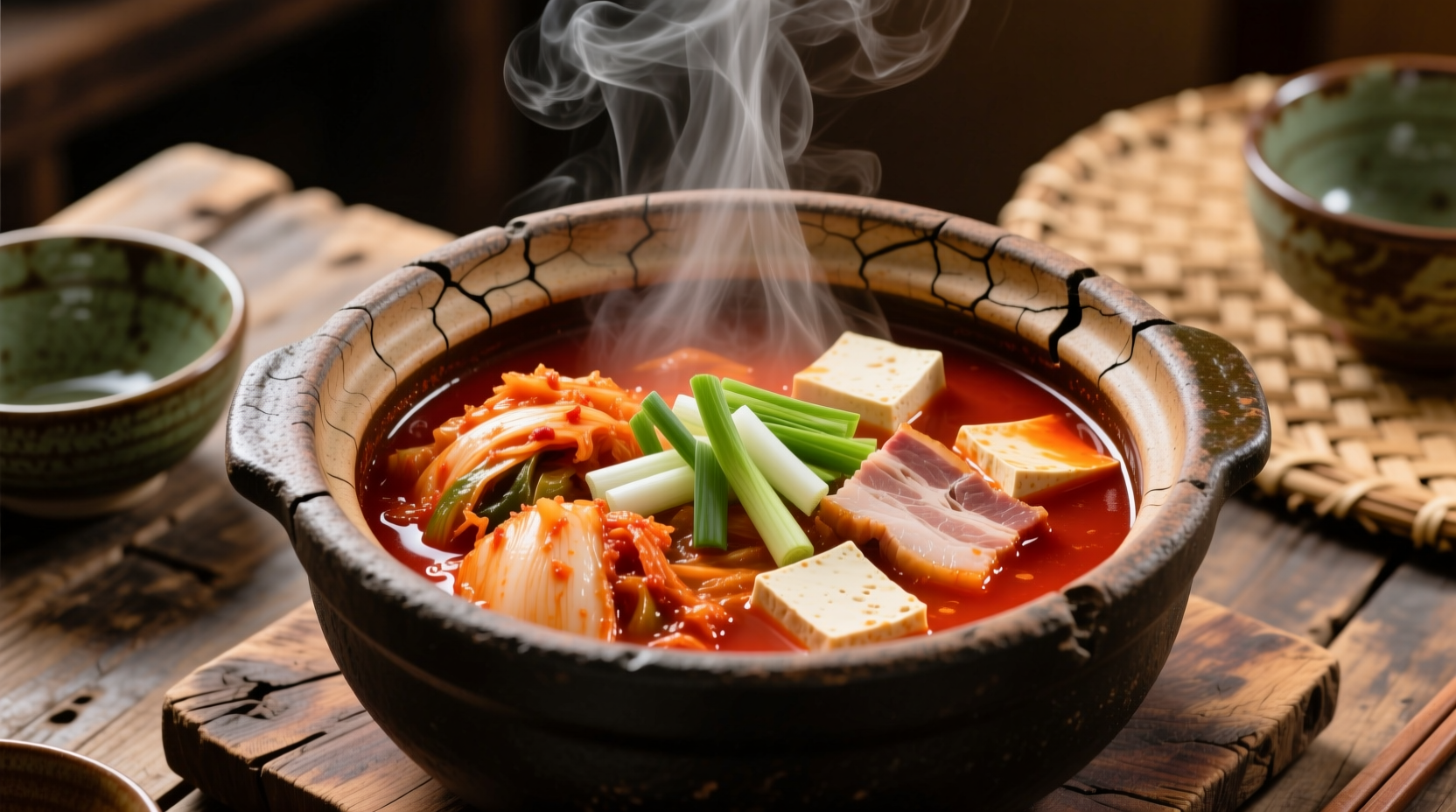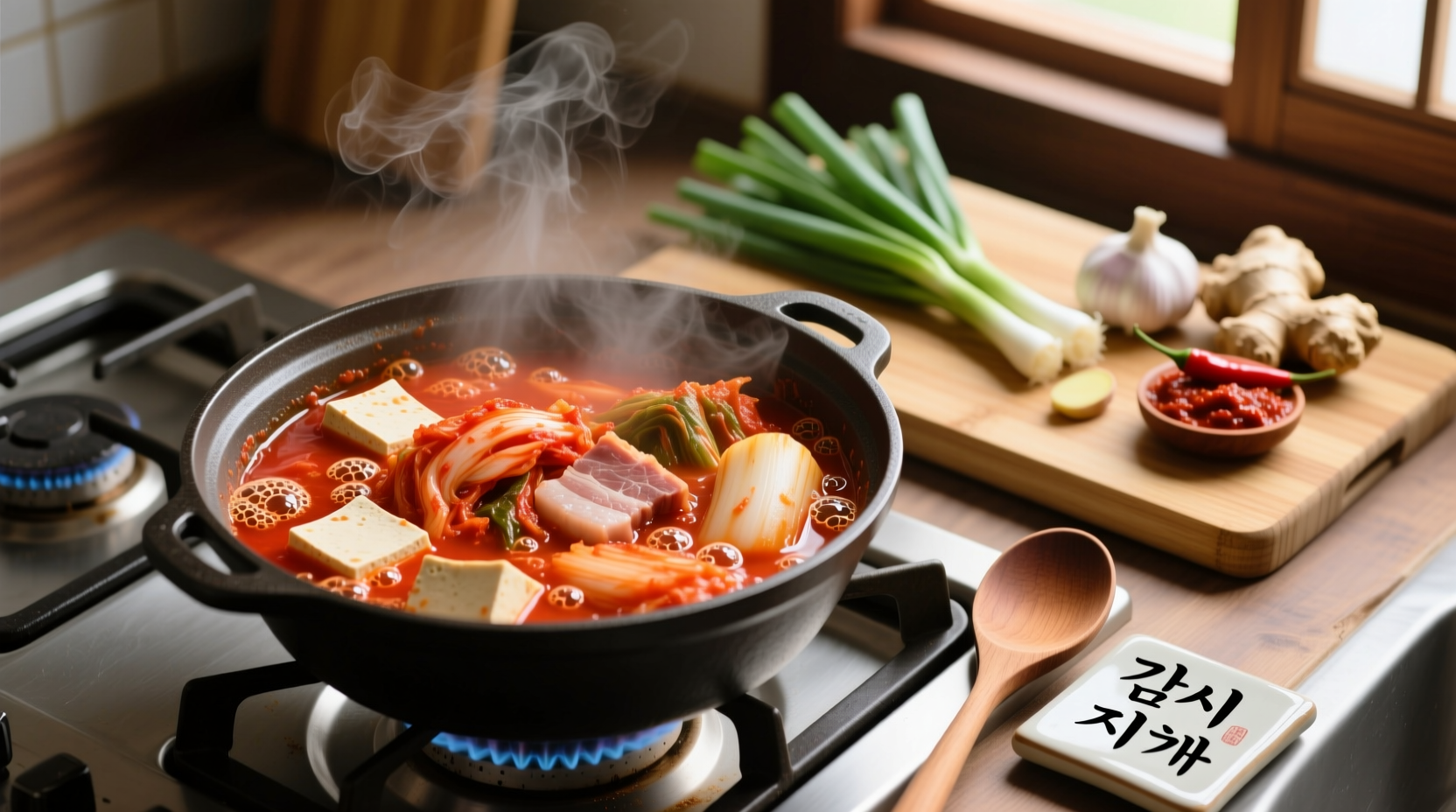Master Authentic Kimchi Chigae in 30 Minutes: Your Complete Cooking Guide
Nothing beats a steaming bowl of kimchi chigae when you need comfort food that's both deeply flavorful and surprisingly quick to prepare. As a Korean comfort food staple, this spicy fermented cabbage stew transforms simple ingredients into a complex, umami-rich meal that warms you from the inside out. In this guide, you'll learn the professional chef techniques that make the difference between a decent kimchi stew and an authentic, restaurant-quality chigae that balances tangy, spicy, and savory notes perfectly.
Why This Kimchi Chigae Recipe Works Every Time
Unlike generic online recipes, this method follows the Korean culinary principle of matgim (맛김) - developing layered flavors through precise ingredient timing. The key is understanding how kimchi's fermentation stage directly impacts your stew's final flavor profile. Most home cooks make the critical mistake of using fresh kimchi, which lacks the necessary sourness to create that signature depth. This guide shows you exactly how to select and use kimchi at the perfect stage of fermentation.
Kimchi Chigae Through the Ages: A Flavor Evolution Timeline
Understanding kimchi chigae's history helps you appreciate why certain techniques matter. Originally developed as a way to use aging kimchi before refrigeration, this stew has evolved significantly:
| Era | Kimchi Stage Used | Key Ingredients | Cooking Method |
|---|---|---|---|
| Pre-1950s | 2-3 month old kimchi | Kimchi, water, minimal seasoning | Clay pot over wood fire |
| 1960-1980s | 3-4 week old kimchi | Added pork, gochujang, tofu | Cast iron pot on coal stove |
| Modern (1990s-present) | 2-4 week old kimchi | Pork belly, gochujang, gochugaru, seafood options | Non-stick pot on gas/electric stove |
Source: Korean Food Promotion Institute (koreanfood.or.kr) historical records
Your Essential Kimchi Selection Guide
The single most important factor in authentic kimchi chigae is selecting the right kimchi. Not all kimchi works equally well for stewing:
| Kimchi Age | Acidity Level | Best For | Stew Outcome |
|---|---|---|---|
| Fresh (1-2 weeks) | Low (pH 4.5-5.0) | Eating raw, pancakes | Bland, lacks depth, requires added vinegar |
| Ideal (2-4 weeks) | Moderate (pH 4.0-4.5) | Kimchi chigae | Perfect balance of tangy and spicy |
| Very Sour (4+ weeks) | High (pH 3.5-4.0) | Stews needing intense sourness | Overpowering sourness, needs sugar balance |
According to food science research from Seoul National University's Department of Food Science and Biotechnology, kimchi reaches its optimal stewing acidity at approximately 21 days of fermentation at 4°C, creating the ideal pH balance for kimchi chigae (snu.ac.kr).
What You'll Need: Ingredients & Equipment
Core ingredients for 2 servings:
- 2 cups aged kimchi (2-4 weeks old) with 1/4 cup brine
- 150g pork belly (or firm tofu for vegetarian)
- 1 tbsp gochujang (Korean red pepper paste)
- 1 tsp gochugaru (Korean red pepper flakes)
- 1 cup anchovy-kelp broth (or water)
- 1/2 cup tofu, cubed
- 2 green onions, sliced
- 1 tsp sesame oil
Essential equipment: Medium-sized pot with lid (not non-stick for authentic flavor development), wooden spoon, sharp knife
The Professional Chef's Step-by-Step Method
Step 1: Prepare Ingredients (5 minutes)
Cut pork belly into 1/4-inch slices. Roughly chop kimchi (larger pieces maintain texture). Cube tofu. Slice green onions diagonally.
Step 2: Build the Flavor Foundation (8 minutes)
Heat pot over medium-high. Add pork belly and cook until fat renders (3-4 minutes). Don't skip this step - the rendered fat carries flavor throughout the stew. Add kimchi and stir-fry for 5 minutes until kimchi softens and releases aroma. This critical step develops char (카), the Korean term for deep roasted flavor.
Step 3: Create the Broth Base (10 minutes)
Add gochujang and gochugaru, stirring to coat kimchi. Pour in broth, bring to gentle boil. Reduce heat, cover, and simmer 7 minutes. The covered simmering allows flavors to meld while preserving kimchi's texture.
Step 4: Final Touches (5 minutes)
Add tofu and green onions. Simmer uncovered 3 minutes. Finish with sesame oil. Never boil vigorously at this stage - it breaks down tofu and makes kimchi mushy.
Avoid These 3 Common Kimchi Chigae Mistakes
Even experienced cooks make these errors that ruin authentic flavor:
| Mistake | Why It Matters | Professional Solution |
|---|---|---|
| Using fresh kimchi | Lacks necessary sourness for depth | Use kimchi aged 2-4 weeks; add 1 tsp vinegar if using fresher kimchi |
| Boiling instead of simmering | Breaks down ingredients, creates bitter notes | Maintain gentle simmer (small bubbles at edges) |
| Adding all ingredients at once | Prevents proper flavor layering | Follow the stir-fry → simmer covered → finish uncovered sequence |
Perfect Pairings: Serving Your Kimchi Chigae
Serve immediately in individual bowls with a bowl of hot rice on the side. Traditional Korean etiquette suggests eating a spoonful of rice with each bite of stew. For complete meal balance, pair with:
- Steamed rice (short-grain preferred)
- Simple spinach banchan (sigeumchi namul)
- Kimchi (different variety than used in stew)
The ideal serving temperature is 75-80°C (167-176°F) - hot enough to maintain warmth but not so hot that it destroys delicate flavors.

Variations for Different Dietary Needs
Vegetarian/Vegan: Substitute pork with mushrooms (shiitake works best) and use vegetable broth. Add 1/2 cup chopped kimchi juice for extra umami.
Seafood Kimchi Chigae: Replace pork with 150g shrimp or clams. Add seafood 5 minutes before serving to prevent overcooking.
Milder Version: Reduce gochugaru by half and add 1 tbsp sugar. Works well with very sour kimchi.
Storage and Reheating for Maximum Flavor
Kimchi chigae actually improves overnight as flavors meld. Store in airtight container for up to 3 days. Reheat gently on stove (not microwave) with a splash of water to refresh broth. The second day's stew often has more balanced flavors as the kimchi's acidity mellowing and integrating with other ingredients.
Frequently Asked Questions
Can I use store-bought kimchi for chigae?
Yes, but choose naturally fermented varieties without preservatives. Check the label for "lacto-fermented" and avoid those with vinegar as the primary acidifier. Let store-bought kimchi sit at room temperature for 24-48 hours to develop more sourness before using.
Why does my kimchi chigae taste bitter?
Bitterness usually comes from over-boiling or using kimchi that's too old. Simmer gently rather than boiling vigorously, and use kimchi aged 2-4 weeks. If already bitter, add 1/2 tsp sugar and a splash of broth to balance.
Can I make kimchi chigae without pork?
Absolutely. Traditional vegetarian versions use mushrooms and tofu for umami. For best results, use shiitake mushrooms that have been soaked in water overnight, then use both mushrooms and soaking liquid in place of pork and broth.











 浙公网安备
33010002000092号
浙公网安备
33010002000092号 浙B2-20120091-4
浙B2-20120091-4